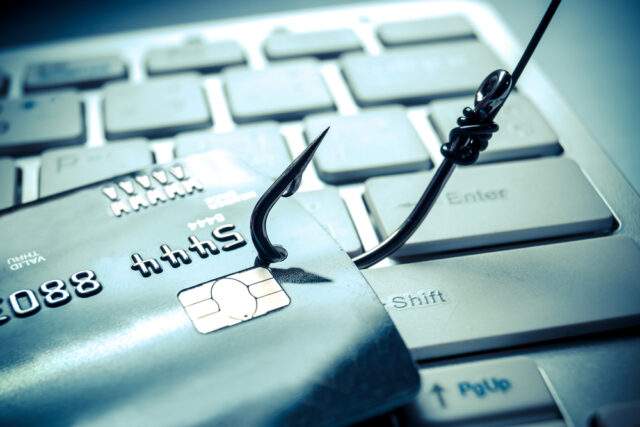What is spear phishing and how do you prevent it?
Read our guide to find out what spear phishing is, why it’s a problem for organizations and how to prevent it.
Read our guide to find out what spear phishing is, why it’s a problem for organizations and how to prevent it.

In today’s digitally connected world, where most businesses rely heavily on online communication and transactions, the risk of falling victim to sophisticated cyber attacks is ever-present. One of the most common online threats is known as spear phishing, a targeted and deceptive tactic employed by hackers to trick individuals into revealing sensitive information or performing actions that compromise their security.
Due to the increasing sophistication of these attacks, and their alarmingly high success rates, businesses must understand the nature of spear phishing as well as the proactive measures they can take to safeguard themselves from hackers.
In this blog, we will cover:
Spear phishing is a type of cyber attack that involves targeted email or electronic communication sent to specific individuals or organizations. It’s a more sophisticated and personalized version of regular phishing attacks, in which the attacker uses tailored research to craft their messages.
The main objective of spear phishing is to deceive the target by creating a sense of familiarity or trust. Here’s how it typically works:
Spear phishing, regular phishing, and whaling are all forms of phishing attacks, but they differ in their targets and levels of sophistication:
Regular phishing is a widespread attack method that involves sending mass emails or messages to numerous individuals in the hopes of tricking some recipients into sharing sensitive information or taking certain actions.
These attacks aim to ensnare as many victims as possible. The emails are often generic and impersonate popular websites or services. Regular phishing attacks do not target specific individuals or organizations.
Spear phishing is a targeted attack that focuses on specific individuals or organizations. The attacker gathers information about their targets, including their name, job position, or affiliations.
The messages are crafted to appear personalized, and the content is often tailored to exploit the target’s interests, relationships, or recent activities, making detection more challenging. Spear phishing attacks are more advanced and have a higher success rate compared to regular phishing attacks.
Also known as CEO fraud, whaling is a specialized form of spear phishing that targets high-profile individuals with significant authority or access to sensitive information.
The attackers impersonate a trusted colleague, business partner, or even the CEO to trick targets into performing detrimental actions that could lead to financial losses or data breaches.
Whaling attacks manipulation of power dynamics within an organization. They often involve urgent requests for wire transfers, confidential information, or access to critical systems.
In the early 2000s, cyber criminals began to recognize the potential of personalized attacks. They exploited the trust individuals had in electronic communication and used social engineering techniques to gather information. These messages aimed to trick individuals into revealing sensitive information or downloading malware.
With the rise of social media and the sheer amount of personal information available online, spear phishing became even more sophisticated by the mid-2000s. Attackers targeted specific groups, using personalized email messages to lure victims into providing confidential information or performing malicious actions.
Today, spear phishing attacks are even more advanced. Attackers employ highly personalized tactics, leveraging research and exploiting vulnerabilities through as many communication channels as possible. They impersonate trusted entities, exploit timely events, and may combine spear phishing with other techniques.
As awareness and cybersecurity measures improve, attackers adapt their techniques to exploit emerging technologies. To stay ahead of potential threats, organizations and individuals must remain vigilant and implement robust security measures.
Bad actors use a diverse number of strategies to target individuals and organizations. And attackers are constantly adapting their tactics to exploit human vulnerabilities and deceive their targets.
Here are some of the most notable types of spear phishing:
Just one successful phishing attack can derail an organization’s entire operation. Here are a few reasons why spear phishing poses serious challenges and risks:
Attackers conduct research to gather information about their targets, enabling them to craft highly personalized and convincing messages.
This level of targeting increases the level of trust and, consequently, the chances of success. Organizations may suffer financial losses, data breaches, or reputational damage if their employees fall victim to these attacks.
Once attackers successfully deceive an employee, they can gain access to valuable data, trade secrets, client information, or financial records. This can lead to data breaches, financial fraud, or theft of intellectual property.
Successful spear phishing attacks can disrupt normal business operations.
For instance, if an attacker gains control over an employee’s account or computer, they can potentially distribute malware, ransomware, or other malicious software within the organization’s network. This can lead to system outages, loss of productivity, and the need for costly recovery measures.
If an employee unknowingly provides their login credentials, attackers can gain unauthorized access to internal systems, email accounts, or cloud services. This can allow the attacker to perform various malicious activities, such as unauthorized transactions, data manipulation, or further exploitation within the infrastructure.
If an organization falls victim to a spear phishing attack, it can result in reputational damage and loss of trust from clients, partners, and stakeholders. The disclosure of a successful attack may erode confidence in the organization’s ability to protect sensitive information, potentially leading to client churn and negative publicity.
The 2016 cyber attack on the Democratic National Committee (DNC) during the U.S. presidential election is a recent example of a successful spear phishing attack. The attackers sent seemingly legitimate emails to DNC employees, posing as trusted entities, such as colleagues or reputable organizations.
These emails contained malicious attachments or links. Once a recipient clicked on the attachment or link, it initiated the download of malware onto their computer systems. Attackers used social engineering tactics and personalized messages to deceive the targets into believing the emails were legitimate.
By compromising several high-level employees, attackers gained unauthorized access to sensitive information, including emails and documents. The stolen information was later leaked, leading to public controversy that impacted the election campaign.
No form of detection is foolproof and detecting spear phishing attacks can be especially challenging since they are carefully crafted to appear legitimate and bypass traditional security measures.
However, here are some tips for early detection:
If you suspect or detect a spear phishing attack, it is crucial to respond promptly and appropriately. Here are some recommended steps to take:
Preventing spear phishing attacks requires a multi-layered approach that combines technological measures, employee education, and proactive security practices.
Here are some key preventive measures:
Thousands of phishing attacks are recorded every day. Although hackers attempt to deceive unsuspecting users on a daily basis, many tech-savvy users no longer fall for the average ploy. However, a more sophisticated, personalized, and highly targeted form of cyber threat has emerged. And its success rate is much higher.
To protect against spear phishing attacks individuals and organizations must adopt a proactive approach, remain vigilant, and follow security practices. This involves being cautious of unsolicited emails, verifying the authenticity of requests through alternate channels, and regularly updating security software.
Although prevention is key, implementing a swift and coordinated response plan is equally as crucial. But if you really want to know how your organization will respond to an attack, you need to put your security system to the test.
CovertSwarm offers expert cybersecurity guidance along with phishing attack simulations. To learn more about our services, reach out to a member of our team.

What is phishing and how can you prevent it?
Read our complete guide to learn what phishing is, different types of attack, how it works and how to prevent it

What is malware and how can you prevent it?
Read our guide to find out what malware is, why it exists, different types and how to prevent it to keep your organization safe.

What is social engineering in cybersecurity?
Discover the ins and outs of social engineering attacks and learn how to identify and prevent them with this comprehensive guide from CovertSwarm.